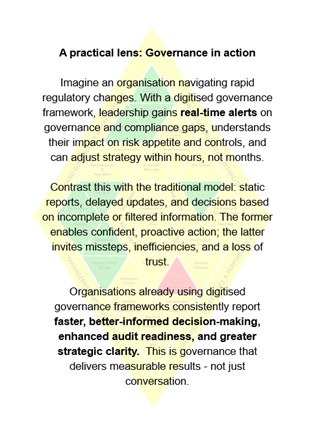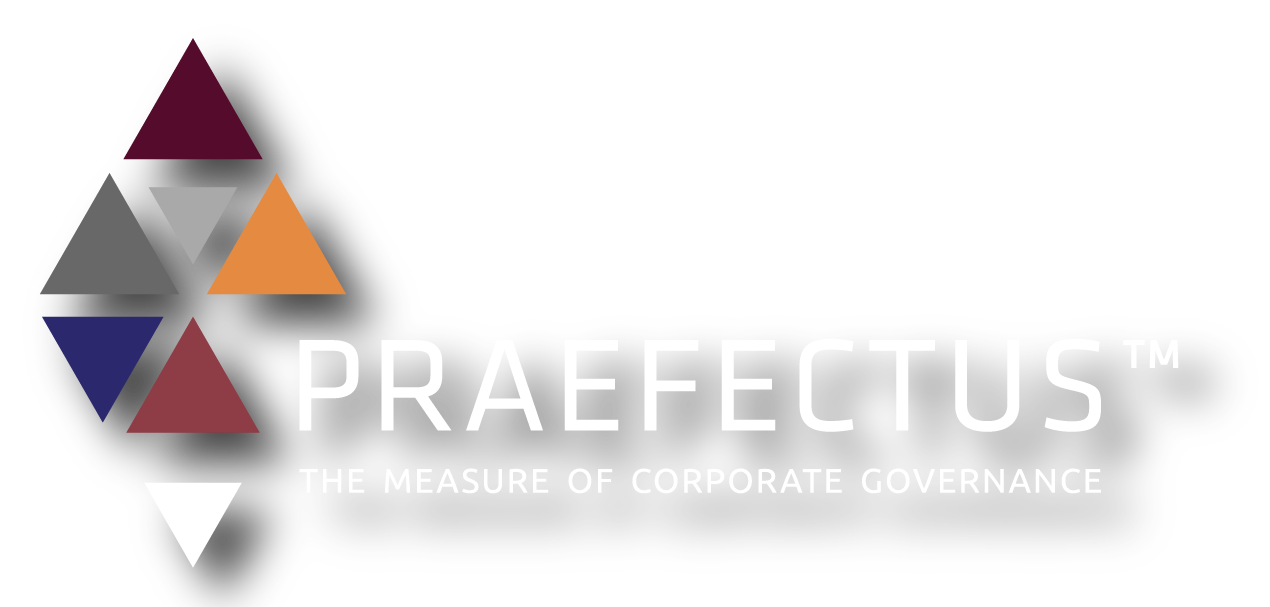Governance conversations everywhere -- in boardrooms, conferences, and social platforms -- are often punctuated by phrases such as “best practice,” “governance with purpose”, and “future-ready boards.” Yet good intentions alone rarely change outcomes. True governance requires boards, executives, and those charged with governance (TCWG) to have practical, timely and structured insights that transform intent into accomplishments. In an era of accelerating risk and disruption, digitised governance frameworks (DGFs) are not merely tools of convenience – they change what boards and management see and how quickly they see it, and act as catalysts for action.
A common belief in governance circles is that management tools only create value once the right capabilities, activities, and behaviours are already entrenched. In practice, however, modern DGFs actually stimulate competency and capacity building by giving impetus to changed behaviour and providing guidance on governance best practice. By setting the standard for expected performance, compliance and risk management, DGF’s can measure the extent to which the organisation’s actions match its stated governance intent. The resultant gap (desired state vs. current state) - which is transparent to both boards and management, prompts decision-making and action at every level within the organisation.
The penetrating breadth and depth of the DGF makes it integral to strategic planning and implementation, moving it well beyond the realms of a ‘mere’ reporting tool which traditional boards consider to be “a nice to have in place”. Instead, DGFs are shaping organisational and board culture by providing compelling insights into governance performance and risks.
Tangible value in action
The business case for DGFs is undeniable and founded on outcomes boards and management care about - namely demonstrable, measurable and sustainable performance. Key benefits of the DGF include:
- Agile decision-making: Up to date, evidence-based dashboards reduce the time between the detection and correction of under- or poor performance and deliberate action, keeping the board and executive leadership aligned, informed, and decisive.
- Resilience and prevention: Early visibility of governance gaps and emerging performance trends enables pre-emptive interventions that drive policymaking and strategy execution. Unmitigated governance risks often lead to penalties, regulatory fines, reputational damage and diminished trust, all of which can have a catastrophic impact on sustainability.
- Strategic performance: DGFs integrate strategic KPIs with risk and operational indicators, making it clear which initiatives are driving value, and which are draining resources. This shifts governance from back-office control to front-line value delivery.
- Stakeholder trust: Demonstrable, auditable evidence of governance performance builds investor, regulator and stakeholder confidence in a way that aspirational statements cannot achieve.
- Assurance as enabler: While robust assurance remains important, it is the downstream effect, namely the confidence DGFs inspire that allows boards to act decisively. Framing DGFs solely as “assurance tools” significantly under values their strategic potential. Evidence-based assessments that can withstand internal and external scrutiny drive confidence in respect of competency and compliance.
- Reputation: Transparently demonstrating that governance outcomes are measured and substantiated by evidence builds credibility with regulators, investors, and stakeholders and creates a powerful competitive differentiator.
Together, these key factors turn governance from a statement of intent into a competitive advantage.
Global alignment, national execution
Boards and management who take advantage of DGFs do more than check governance boxes: they translate standards into observable performance. In line with the expectations of King V™ in South Africa, the OECD Corporate Governance Principles and ISO37000, DGFs make it possible to benchmark governance maturity with measurable outcomes and verifiable evidence, demonstrating progress over time and delivering sustainable value.
Bridging the governance rhetoric gap
The governance conference and seminar circuit offers valuable reminders of important governance principles. However, sometimes too much time is spent on establishing the difference between models and frameworks, and too little guidance and time is spent understanding those practical challenges which ultimately shape decision-making and resource allocations.
Consider the myth: “Boards must be firmly established, with comprehensive board skills and training before they can benefit from DGFs.” The reality is that DGFs accelerate board readiness.

Even newly appointed directors without prior boardroom experience can use real-time DGF dashboards to ask focused, evidence-based questions from day one - such as why certain indicators are persistently red, and what corrective measures are being implemented? The DGF reveals performance patterns and exceptions, shortening the learning curve for directors to gain a comprehensive understanding of the GRC matters impacting organisational performance. Being able to “hit the road running” makes incoming directors more effective, more quickly, while ensuring that seasoned directors also continue to operate with timely, and tested insight.
Enabling collective governance
A digitised governance framework simplifies governance by giving boards and management a clear snapshot of key governance indicators, it also provides verifiable evidence to support governance assessments. Without it, directors would be required to request “walkthroughs” by management of how governance data was derived, or to petition that evidence for every risk indicator be included in the board packs. The sheer volume of such information on its own will likely deter from the board’s good intentions to exercise effective oversight.
Instead, digitised governance frameworks are being tailored and used to embed and align corporate behaviour with desired outcomes. Culture remains an organisation’s strongest first line of defense. This is where governance stops being abstract, where well-worn phrases gain meaning, and where governance talk is finally transformed into action with measurable impact.
ENDS
Words: 902
For further information contact:
Terrance M. Booysen (CGF: Chief Executive Officer) - Cell: +27 (0)82 373 2249 / E-mail: [email protected]
Jené Palmer (CGF: Director)) - Cell: +27 (0)82 903 6757 / E-mail: [email protected]
CGF Research Institute (Pty) Ltd - Tel: +27 (0)11 476 8261 / Web: www.cgfresearch.co.za
Follow CGF on X: @CGFResearch
Click below to read more...

